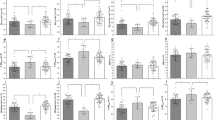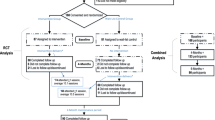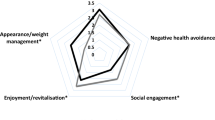Abstract
Study design
Cross-sectional construct validation study.
Objectives
To test the construct validity of the Leisure Time Physical Activity Questionnaire for People with Spinal Cord Injury (LTPAQ-SCI) by examining associations between the scale responses and cardiorespiratory fitness (CRF) in a sample of adults living with spinal cord injury (SCI).
Setting
Three university-based laboratories in Canada.
Methods
Participants were 39 adults (74% male; M age: 42 ± 11 years) with SCI who completed the LTPAQ-SCI and a graded exercise test to volitional exhaustion using an arm-crank ergometer. One-tailed Pearson’s correlation coefficients were computed to examine the association between the LTPAQ-SCI measures of mild-, moderate-, heavy-intensity and total minutes per week of LTPA and CRF (peak volume of oxygen consumption [V̇O2peak] and peak power output [POpeak]).
Results
Minutes per week of mild-, moderate- and heavy-intensity LTPA and total LTPA were all positively correlated with V̇O2peak. The correlation between minutes per week of mild intensity LTPA and V̇O2peak was small-medium (r = 0.231, p = 0.079) while all other correlations were medium-large (rs ranged from 0.276 to 0.443, ps < 0.05). Correlations between the LTPAQ-SCI variables and POpeak were also positive but small (rs ranged from 0.087 to 0.193, ps > 0.05), except for a medium-sized correlation between heavy-intensity LTPA and POpeak (r = 0.294, p = 0.035).
Conclusions
People with SCI who report higher levels of LTPA on the LTPAQ-SCI also demonstrate greater levels of CRF, with stronger associations between moderate- and heavy-intensity LTPA and CRF than between mild-intensity LTPA and CRF. These results provide further support for the construct validity of the LTPAQ-SCI as a measure of LTPA among people with SCI.
Similar content being viewed by others
Log in or create a free account to read this content
Gain free access to this article, as well as selected content from this journal and more on nature.com
or
Data availability
The datasets generated during and/or analysed during the current study are available from the corresponding author on reasonable request.
References
van der Scheer JW, Martin Ginis KA, Ditor DS, Goosey-Tolfrey V, Hicks AL, West CR, et al. Effects of exercise on fitness and health of adults with spinal cord injury: a systematic review. Neurology. 2017;89:736–45.
Martin Ginis KA, Jetha A, Mack DE, Hetz S. Physical activity and subjective well-being among people with spinal cord injury: a meta-analysis. Spinal Cord. 2010;48:65–72.
Farrow M, Nightingale T, Maher J, McKay C, Thompson D, J B. The effect of exercise on cardiometabolic risk factors in adults with chronic spinal cord injury: a systematic review: exercise and CMS risk in SCI. Arch Phys Med Rehabilit 2020. https://doi.org/10.1016/j.apmr.2020.04.020.
Martin Ginis KA, Latimer AE, Arbour-Nicitopoulos KP, Buchholz AC, Bray SR, Craven BC, et al. Leisure time physical activity in a population-based sample of people with spinal cord injury Part I: demographic and injury-related correlates. Arch Phys Med Rehabilit. 2010;91:722–8.
Williams TL, Smith B, Papathomas A. The barriers, benefits and facilitators of leisure time physical activity among people with spinal cord injury: a meta-synthesis of qualitative findings. Health Psychol Rev. 2014;8:404–25.
Tsang K, Hiremath SV, Crytzer TM, Dicianno BE, Ding D. Validity of activity monitors in wheelchair users: a systematic review. J Rehabil Res Dev. 2016;53:641–58.
Nightingale TE, Rouse PC, Thompson D, Bilzon JLJ. Measurement of physical activity and energy expenditure in wheelchair users: methods, considerations and future directions. Sports Med - open. 2017;3:10.
Lankhorst K, Oerbekke M, van den Berg-Emons R, Takken T, de Groot J. Instruments measuring physical activity in individuals who use a wheelchair: a systematic review of measurement properties. Arch Phys Med Rehabilitation. 2020;101:535–52.
Ma JK, McCracken LA, Voss C, Chan FHN, West CR, Martin Ginis KA. Physical activity measurement in people with spinal cord injury: comparison of accelerometry and self-report (the Physical Activity Recall Assessment for People with Spinal Cord Injury). Disabil Rehabilit. 2020;42:240–6.
Conger SA, Scott SN, Fitzhugh EC, Thompson DL, Bassett DR. Validity of physical activity monitors for estimating energy expenditure during wheelchair propulsion. J Phys Act Health. 2015;12:1520–6.
Collins EG, Gater D, Kiratli J, Butler J, Hanson K, Langbein WE. Energy cost of physical activities in persons with spinal cord injury. Med Sci Sports Exerc. 2010;42:691–700.
Martin Ginis KA, van der Scheer JW, Latimer-Cheung AE, Barrow A, Bourne C, Carruthers P, et al. Evidence-based scientific exercise guidelines for adults with spinal cord injury: An update and a new guideline. Spinal Cord. 2018;56:308–21.
Martin Ginis KA, Latimer AE, Craven BC, Hicks AL. Development and evaluation of an activity measure for people with spinal cord injury. Med Sci Sports Exerc. 2005;37:1099–111.
Tanhoffer RA, Tanhoffer AI, Raymond J, Hills AP, Davis GM. Comparison of methods to assess energy expenditure and physical activity in people with spinal cord injury. J Spinal Cord Med. 2012;35:35–45.
Martin Ginis KA, Latimer-Cheung AE Physical Activity Recall Assessment for People with Spinal Cord Injury (PARA-SCI): https://sciactioncanada.ok.ubc.ca/resources/para-sci-manual/. Accessed May 2020.
Latimer AE, Martin Ginis KA, Craven BC, Hicks AL. The physical activity recall assessment for people with spinal cord injury: validity. Med Sci Sports Exerc. 2006;38:208–16.
Martin Ginis KA, Phang SH, Latimer AE, Arbour-Nicitopoulos KP. Reliability and validity tests of the leisure time physical activity questionnaire for people with spinal cord injury. Arch Phys Med Rehabilit. 2012;93:677–82.
Craig CL, Marshall AL, Sjostrom M, Bauman AE, Booth ML, Ainsworth BE, et al. International physical activity questionnaire: 12-country reliability and validity. Med Sci Sports Exerc. 2003;35:1381–95.
Cummings I, Lamontagne M-E, Sweet SN, Spivock M, Batcho CS. Canadian-French adaptation and test-retest reliability of the leisure time physical activity questionnaire for people with disabilities. Ann Phys Rehabilitation Med. 2019;62:161–7.
Streiner DL, Norman GR, Cairney J Health Measurement ScalesA practical guide to their development and use, Oxford University Press, New York; 2015.
Ma JK, West CR, Martin, Ginis KA. The effects of a patient and provider co-developed, behavioral physical activity intervention on physical activity, psychosocial predictors, and fitness in individuals with spinal cord injury: a randomized controlled trial. Sports Med. 2019;49:1117–31.
Lithopoulos A, Bassett-Gunter RL, Martin Ginis KA, Latimer-Cheung AE. The effects of gain- versus loss-framed messages following health risk information on physical activity in individuals with multiple sclerosis. J Health Commun. 2017;22:523–31.
Barbonetti A, Cavallo F, D’Andrea S, Muselli M, Felzani G, Francavilla S, et al. Lower vitamin D levels are associated with depression in people with chronic spinal cord injury. Arch Phys Med Rehabil. 2017;98:940–6.
Stapleton JN, Perrier M-J, Campbell DS, Tawse HL, Martin, Ginis KA. Social cognitive predictors of competitive level among athletes with physical disabilities. Psychol Sport Exerc. 2016;22:46–52.
Cronbach LJ, Meehl PE. Construct validity in psychological tests. Psychological Bull. 1955;52:281–302.
Hicks AL, Martin Ginis KA, Pelletier CA, Ditor DS, Foulon B, Wolfe DL. The effects of exercise training on physical capacity, strength, body composition and functional performance among adults with spinal cord injury: a systematic review. Spinal Cord. 2011;49:1103–27.
Krassioukov AV, Currie KD, Hubli M, Nightingale TE, Alrashidi AA, Ramer L, et al. Effects of exercise interventions on cardiovascular health in individuals with chronic, motor complete spinal cord injury: protocol for a randomised controlled trial [Cardiovascular Health/Outcomes: improvements created by exercise and education in SCI (CHOICES) Study]. BMJ Open. 2019;9:e023540.
Kirshblum SC, Burns SP, Biering-Sorensen F, Donovan W, Graves DE, Jha A, et al. International standards for neurological classification of spinal cord injury (revised 2011). J Spinal Cord Med. 2011;34:535–46.
Eerden S, Dekker R, Hettinga FJ. Maximal and submaximal aerobic tests for wheelchair-dependent persons with spinal cord injury: a systematic review to summarize and identify useful applications for clinical rehabilitation. Disabil Rehabil. 2018;40:497–521.
Scherr J, Wolfarth B, Christle JW, Pressler A, Wagenpfeil S, Halle M. Associations between Borg’s rating of perceived exertion and physiological measures of exercise intensity. Eur J Appl Physiol. 2013;113:147–55.
Edvardsen E, Hem E, Anderssen SA. End criteria for reaching maximal oxygen uptake must be strict and adjusted to sex and age: a cross-sectional study. PLoS One. 2014;9:e85276.
Simmons OL, Kressler J, Nash MS. Reference fitness values in the untrained spinal cord injury population. Arch Phys Med Rehabil. 2014;95:2272–8.
Streiner DL. Best (but oft-forgotten) practices: the multiple problems of multiplicity—whether and how to correct for many statistical tests. Am J Clin Nutr. 2015;102:721–8.
Cohen J. A power primer. Psychological Bull. 1992;112:155–9.
van der Scheer JW, de Groot S, Tepper M, Faber W, Veeger DH, van der Woude LH. Low-intensity wheelchair training in inactive people with long-term spinal cord injury: a randomized controlled trial on fitness, wheelchair skill performance and physical activity levels. J Rehabil Med. 2016;48:33–42.
Lee PH, Macfarlane DJ, Lam TH, Stewart SM. Validity of the international physical activity questionnaire short form (IPAQ-SF): a systematic review. Int J Behav Nutr Phys Act. 2011;8:115.
Bouchard C, An P, Rice T, Skinner JS, Wilmore JH, Gagnon J, et al. Familial aggregation ofV˙o 2 max response to exercise training: results from the HERITAGE family study. J Appl Physiol. 1999;87:1003–8.
West CR, Gee CM, Voss C, Hubli M, Currie KD, Schmid J, et al. Cardiovascular control, autonomic function, and elite endurance performance in spinal cord injury. Scand J Med Sci Sports. 2015;25:476–85.
Goodwin LD, Leech NL. Understanding correlation: factors that affect the size of r. J Exp Educ. 2006;74:249–66.
Booth M. Assessment of physical activity: an international perspective. Res Q Exerc Sport. 2000;71:114–20.
Perrier MJ, Stork MJ, Martin Ginis KA. Type, intensity and duration of daily physical activities performed by adults with spinal cord injury. Spinal Cord. 2017;55:64–70.
Hettinga FJ, Valent L, Groen W, van Drongelen S, de Groot S, van der Woude LHV. Hand-cycling: an active form of wheeled mobility, recreation, and sports. Phys Med rehabilitation Clin North Am. 2010;21:127–40.
Au JS, Totosy De Zepetnek JO, Macdonald MJ. Modeling perceived exertion during graded arm cycling exercise in spinal cord injury. Med Sci Sports Exerc. 2017;49:1190–6.
Totosy de Zepetnek JO, Au JS, Hol AT, Eng JJ, MacDonald MJ. Predicting peak oxygen uptake from submaximal exercise after spinal cord injury. Appl Physiol Nutr Metab. 2016;41:775–81.
Hiremath SV, Ding D, Farringdon J, Vyas N, Cooper RA. Physical activity classification utilizing SenseWear activity monitor in manual wheelchair users with spinal cord injury. Spinal Cord. 2013;51:705–9.
Nightingale TE, Walhin JP, Thompson D, Bilzon JLJ Predicting physical activity energy expenditure in wheelchair users with a multisensor device. BMJ Open Sport Exercise Med. 2015; 1: bmjsem-2015-000008. https://doi.org/10.1136/bmjsem-2015-000008.
Acknowledgements
We thank Adrienne Sinden for her assistance with manuscript preparation.
Funding
This study was funded by a project grant from the Canadian Institutes of Health Research (CIHR) with the funding reference number (TCA 118348). The first author holds the Reichwald Family Southern Medical Program Chair in Chronic Disease Prevention.
Author information
Authors and Affiliations
Contributions
KAMG was responsible for conceptualizing and designing the study, interpreting results and writing the report. JU-C was responsible for analyzing the data, writing the results, creating tables and providing feedback on the report. AAA was responsible for collecting and cleaning the data, drafting the methods section and providing feedback on the report. TEN was responsible for assisting during data collection, drafting the methods section, assisting with data interpretation, and providing feedback on the report. JSA was responsible for assisting in the design of the study protocol, drafting the methods section, assisting with data interpretation, and providing feedback on the report. KDC was responsible for assisting during data collection and providing feedback on the report. MH was responsible for assisting during data collection and providing feedback on the report. AK is the Principal Investigator for the CHOICES study and was responsible for designing and overseeing implementation of all aspects of the CHOICES protocol and providing feedback on the report.
Corresponding author
Ethics declarations
Conflict of interest
The authors declare that they have no conflict of interest.
Ethics
Ethics approval was obtained from the University of British Columbia (H12-02945-11), McMaster University (12–672) and Toronto Rehabilitation Institute – University Health Network (12–5797).
Additional information
Publisher’s note Springer Nature remains neutral with regard to jurisdictional claims in published maps and institutional affiliations.
Rights and permissions
About this article
Cite this article
Martin Ginis, K.A., Úbeda-Colomer, J., Alrashidi, A.A. et al. Construct validation of the leisure time physical activity questionnaire for people with SCI (LTPAQ-SCI). Spinal Cord 59, 311–318 (2021). https://doi.org/10.1038/s41393-020-00562-9
Received:
Revised:
Accepted:
Published:
Issue date:
DOI: https://doi.org/10.1038/s41393-020-00562-9
This article is cited by
-
Influence of time since injury and physical activity level on upper limb kinematics and muscle activation during wheelchair propulsion in complete T12/L1 spinal cord injury
BMC Musculoskeletal Disorders (2025)
-
A Comparison of Neuropathic Pain Experiences Among Paralympic Versus Recreational Athletes with Spinal Cord Injury
Sports Medicine - Open (2023)
-
The effects of active upper-limb versus passive lower-limb exercise on quality of life among individuals with motor-complete spinal cord injury
Spinal Cord (2022)
-
Implementation of the spinal cord injury exercise guidelines in the hospital and community settings: Protocol for a type II hybrid trial
Spinal Cord (2022)
-
Associations between left ventricular structure and function with cardiorespiratory fitness and body composition in individuals with cervical and upper thoracic spinal cord injury
Spinal Cord (2021)



